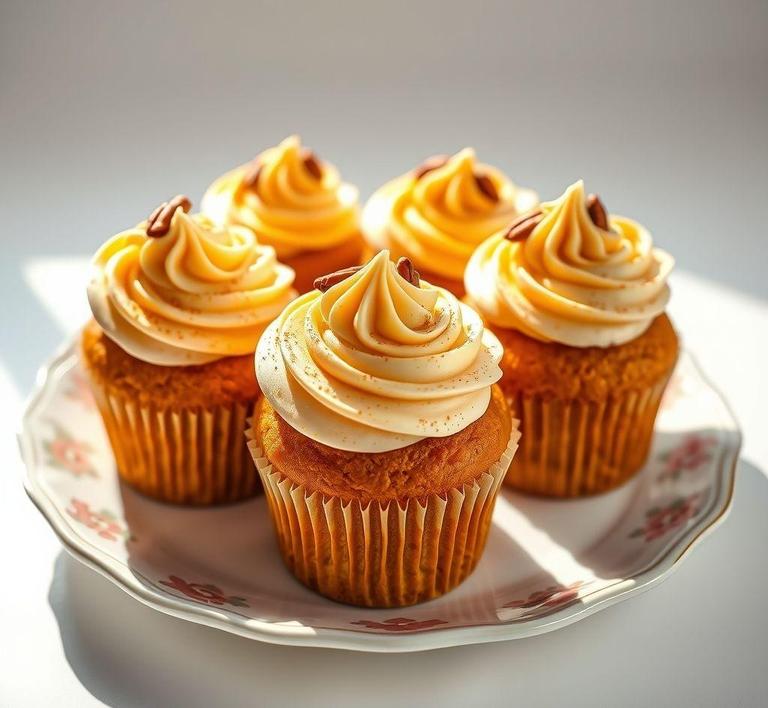If you’ve ever baked a batch of pumpkin cupcakes and found yourself with leftovers, you might be wondering if you can refreeze them for later enjoyment. Refreezing pumpkin cupcakes is definitely possible, and it’s a great way to preserve those delicious seasonal treats. Whether you want to keep them fresh for a future occasion or simply avoid food waste, learning the best way to freeze and refreeze pumpkin cupcakes ensures they’ll stay moist and flavorful. In this guide, we’ll walk you through step-by-step tips on how to freeze, defrost, and refreeze these spiced delights so they taste just as good as the day you made them!
Can You Refreeze Pumpkin Cupcakes?

When it comes to pumpkin cupcakes-those moist, spiced delights that often appear in the fall and holiday seasons-the question of refreezing can be a bit tricky. The short answer is: yes, you technically can refreeze pumpkin cupcakes, but with important caveats related to food safety and quality.
Pumpkin cupcakes, like most baked goods, contain moisture and sugars that freeze well, but repeated freezing and thawing cycles can degrade their texture and flavor. Additionally, if the cupcakes have perishable elements-like cream cheese frosting or whipped cream-they must be handled with extra caution.
Food safety guidelines generally advise against refreezing any food that has been thawed at room temperature for an extended period or left out for more than two hours, as this can promote bacterial growth. However, if the cupcakes were thawed in the refrigerator and have remained cold, they are safer candidates for refreezing.
Ultimately, whether you should refreeze pumpkin cupcakes depends on how they were stored after thawing and if their quality remains intact. Understanding this balance is key to ensuring you enjoy your pumpkin treats safely and deliciously.
How To Refreeze Pumpkin Cupcakes?
Refreezing pumpkin cupcakes requires a bit of care to maintain their texture, flavor, and safety. Here’s a step-by-step guide on how to do it properly:
- Ensure Proper Initial Freezing: Before even considering refreezing, make sure your pumpkin cupcakes were originally frozen correctly. They should have been cooled completely after baking, wrapped tightly in plastic wrap or aluminum foil, and placed in an airtight container or freezer bag to prevent freezer burn.
- Thawing Safely: When thawing your pumpkin cupcakes for consumption, do so in the refrigerator-not on the countertop. This slows bacterial growth and keeps the cupcakes at a safe temperature.
- Evaluate Before Refreezing: After thawing, inspect the cupcakes carefully. If you notice any off smells, mold, or unusual texture changes, discard them. If they still seem fresh and have been refrigerated continuously, they are eligible for refreezing.
- Wrap Each Cupcake Individually: To protect the cupcakes from freezer burn and preserve moisture, wrap each cupcake individually in plastic wrap. For extra protection, place the wrapped cupcakes in a resealable freezer bag or an airtight container.
- Freeze Quickly: Place the cupcakes in the coldest part of your freezer to ensure a rapid freeze. Rapid freezing helps maintain the cupcake’s texture and slows the formation of large ice crystals that can damage the crumb.
- Label with Date: Always label your packages with the refreeze date. Pumpkin cupcakes can generally be frozen for up to 2-3 months for best quality.
By following these steps, you maximize the chance of preserving your pumpkin cupcakes’ flavor and moisture even after a second freeze.
Quality Impact
While refreezing pumpkin cupcakes is possible, it’s important to understand the quality implications that come along with it.
- Texture Changes: The biggest hit usually comes in texture. Each freeze-thaw cycle causes ice crystals to form and then melt, disrupting the cupcake’s delicate crumb structure. The result can be a drier, denser cupcake or one with a crumb that falls apart more easily.
- Moisture Loss: Pumpkin cupcakes rely heavily on moisture for their signature moistness and tender crumb. Refreezing often leads to moisture loss, which can make the cupcakes feel less fresh and more crumbly or dry.
- Flavor Deterioration: The rich spices and pumpkin flavor can fade slightly, especially if the cupcakes weren’t tightly sealed or were stored too long between freezes. Additionally, freezer odors can sometimes seep in, altering the flavor profile.
- Frosting Concerns: If your pumpkin cupcakes have cream cheese frosting or any dairy-based topping, refreezing can affect the frosting’s consistency. It may separate, become grainy, or lose its smooth texture, which impacts the overall eating experience.
In essence, while refreezing pumpkin cupcakes doesn’t necessarily ruin them, you should temper expectations regarding freshness and texture. They may be best suited for immediate consumption after the initial thaw or repurposed in creative ways (think pumpkin cupcake trifle or bread pudding) if the texture changes are noticeable.
Refreezing pumpkin cupcakes is a practical option when you want to minimize waste and extend their shelf life, but it should be approached with care. From a food safety perspective, ensuring that cupcakes were thawed properly and kept refrigerated is crucial to avoid harmful bacterial growth. From a quality standpoint, expect some compromise in texture and moisture, particularly if the cupcakes contain delicate frostings or have undergone multiple freeze-thaw cycles.
If you need to refreeze pumpkin cupcakes, wrap them well, freeze them quickly, and consume them within a reasonable timeframe to enjoy them at their best. Otherwise, consider alternative ways to enjoy leftover pumpkin cupcakes after thawing, such as reheating or incorporating them into desserts, rather than repeatedly freezing and thawing.
Ultimately, with mindful handling, refreezing pumpkin cupcakes can be a safe and reasonable way to keep your fall favorites available longer-just don’t expect the exact same bakery-fresh experience the second time around!
Is It Safe To Refreeze Pumpkin Cupcakes?
When it comes to pumpkin cupcakes, the question of whether it’s safe to refreeze them is layered with considerations about food safety, texture, and taste. Pumpkin cupcakes are a moist, spiced treat with a relatively delicate crumb structure and often contain dairy elements such as cream cheese frosting or butter, which can complicate freezing protocols.
From a food safety perspective, refreezing perishable baked goods like pumpkin cupcakes is generally safe only if the cupcakes were thawed properly and haven’t been left out at room temperature for more than two hours. If the cupcakes were thawed in the refrigerator, kept cold, and not exposed to bacteria-promoting conditions, then refreezing will not pose a significant health risk.
However, frequent freezing and thawing cycles can compromise the quality of the cupcakes. Pumpkin’s high moisture content combined with dairy or egg ingredients means that ice crystals forming and melting multiple times can lead to soggy, crumbly, or dry textures. The frosting can separate or become grainy, and the spices might lose their freshness.
In short: You can refreeze pumpkin cupcakes safely if handled correctly, but the texture and flavor may suffer. It’s best to plan ahead and freeze in smaller portions or single servings to avoid repeated freezing.
Signs That Pumpkin Cupcakes Should Not Be Refrozen
Not every batch of pumpkin cupcakes is a candidate for refreezing. Certain signs indicate that the cupcakes have deteriorated enough to make refreezing unsafe or undesirable:
- Visible Mold or Off Smells: Any sign of mold growth or sour, rancid, or fermented odors means the cupcakes should be discarded immediately.
- Excessive Moisture or Sliminess: If the cupcakes feel overly soggy, sticky, or slimy to the touch, it means spoilage or bacterial activity might have started.
- Frosting Separation or Discoloration: Cream cheese or butter-based frostings that look curdled, oily, or have changed color are no longer fresh.
- Unusual Taste or Texture: If the cupcakes taste stale, sour, or have an off texture after thawing, refreezing will not improve this – it will only degrade them further.
- Left Out Too Long: Cupcakes left out at room temperature for over 2 hours after thawing, especially in warm environments, harbor bacteria that multiply quickly, making refreezing unsafe.
Recognizing these warning signs helps prevent foodborne illness and ensures you enjoy your pumpkin cupcakes at their best quality.
Common Refreezing Mistakes
Even the best intentions can go awry when refreezing pumpkin cupcakes. Here are some pitfalls to avoid:
- Refreezing Without Refrigeration: Thawing cupcakes at room temperature and then immediately refreezing traps bacteria and moisture changes inside, accelerating spoilage.
- Refreezing Multiple Times: Every freeze-thaw cycle degrades the cupcake’s structure and flavor. Repeated cycles cause ice crystal damage leading to dryness or sogginess.
- Freezing Frosted Cupcakes Improperly: Frosting can crack, separate, or become grainy if frozen uncovered or too long. Frosted cupcakes require airtight packaging.
- Using Poor Packaging: Storing cupcakes in non-airtight containers or plastic wrap that allows moisture in or out invites freezer burn and staleness.
- Not Labeling or Dating: Without proper labeling, cupcakes may be kept in the freezer too long, risking quality loss or confusion about freshness.
Avoiding these mistakes preserves both the safety and sensory delight of pumpkin cupcakes.
Tips And Tricks
To keep pumpkin cupcakes delicious and safe when freezing and refreezing, here are some pro tips:
- Freeze Before Frosting: If possible, freeze cupcakes uniced and frost after thawing for the best texture.
- Use Airtight Packaging: Wrap cupcakes tightly in plastic wrap, then place them in a ziplock or vacuum-sealed bag to prevent freezer burn.
- Freeze in Single Portions: This avoids having to refreeze the whole batch; just thaw what you need.
- Thaw in Refrigerator: Always thaw cupcakes overnight in the fridge to keep them at safe temperatures.
- Consume Quickly After Thawing: For best taste and safety, eat thawed cupcakes within 2-3 days and avoid refreezing unless absolutely necessary.
- Label Everything: Date your packages so you can track how long they’ve been frozen-ideally, consume within 2-3 months for peak quality.
With these strategies, your pumpkin cupcakes can stay moist, flavorful, and safe through freezing adventures.
Conclusion
In the delightful world of pumpkin cupcakes, freezing and refreezing can be both a blessing and a challenge. While it’s generally safe to refreeze pumpkin cupcakes under the right conditions, the reality is that each freeze-thaw cycle chips away at their moist crumb, spiced aroma, and luscious frosting. By recognizing the signs of spoilage, avoiding common mistakes, and applying smart freezing techniques, you can enjoy your pumpkin cupcakes well beyond their baking day with minimal compromise to taste and texture.
In essence, treat your pumpkin cupcakes with a little TLC during freezing, and they will reward you with a cozy autumn treat anytime you crave it-no matter the season!


